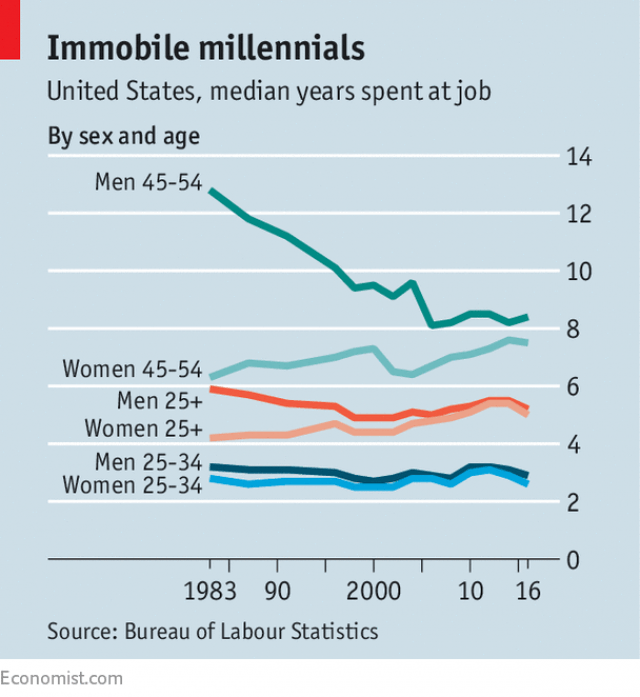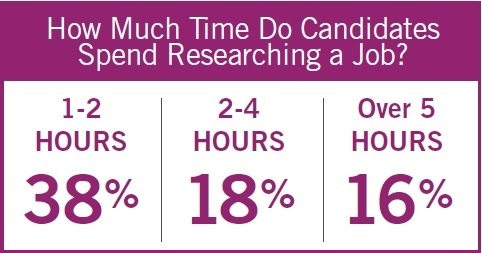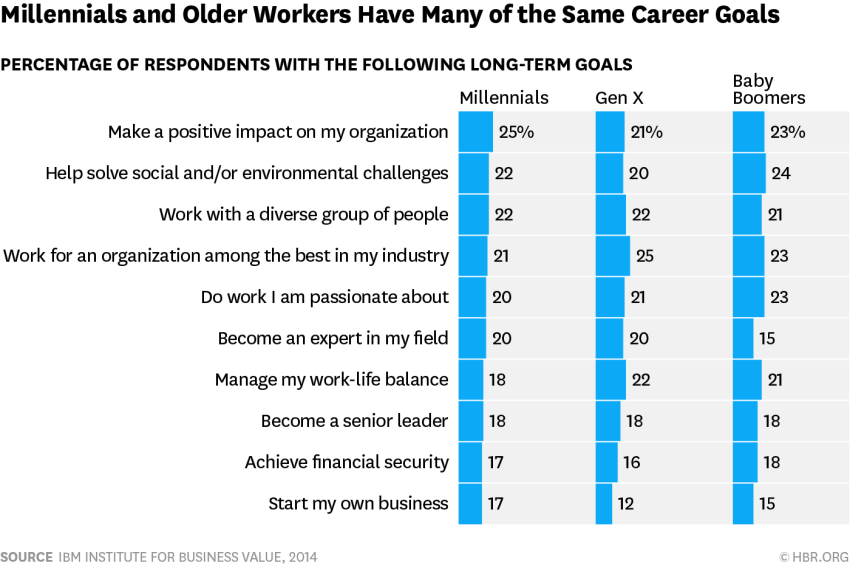Candidates: Are you interviewing and need support?
As of 2016, millennials became the largest generation in the US workforce. Two years later, attracting them is still one of HR’s biggest challenges.
What’s happening? In this post, we’ll look at six different, data-backed ways you can attract more millennials to your workplace.
1) Rethink Stereotypes
When dealing with any generational demographic it’s tempting to lean on stereotypes. But if you focus on stereotypes over data, you’ll miss the strategies that actually work.
For instance, you wouldn’t expect digitally-savvy millennials to frequent their local library - but they are actually more likely to visit than Gen-Xers or baby boomers.
And the “job-hopping” millennial? A myth:

Millennials change jobs just as often as previous generations did in their youth. When you crack open stereotypes, you uncover methods of attracting millennial talent that other organizations won’t think of.
Consider that only 20% of millennials moved in the previous year: down ~25% from previous generations. The implication here is two-fold:
- Localized recruiting isn’t dead. It’s more compelling than ever. Your local competitors - who think millennials are constantly on the move - might have given up on local recruiting events.
- There’s huge opportunity to recruit millennial “boomerang” candidates. Since millennials aren’t picking up and moving when they find a new job, it’s easier to recruit them back to your company if they leave.
When you confront stereotypes with data, surprising solutions emerge.
2) Nail Down Review Sites
Millennials trust user-generated content (peer reviews, etc) 50% more than traditional media. This isn’t to say other generations don’t, this particular study just looked at millennials.
A strong reputation and presence on review sites sends potential applicants a compelling message. A poor reputation tells them not to apply.
It’s important to manage your reputation on a range of review sites. 72% of candidates spend over an hour researching a job; they’ll visit multiple.

Talent Board, 2016
So what do you do if your Glassdoor (or other review site) company page is full of less-than-glowing reviews?
- Report the false reviews. Comb through your reviews and flag those that are clearly false or not written by a current or past employee or candidate.
- Respond to high-profile negative reviews. Glassdoor allows users to rate reviews as “helpful”. Prioritize responding to negative reviews that have a high “helpful” rating.
- Accept, grow, & improve. The steps you take to improve overall company culture are wholly dependent on your organization; there are few general principles here. When you view all negative reviews as an opportunity to grow, they become a powerful tool that reveals what you should prioritize.
3) Corporate Social Responsibility
Millennials place a high importance on corporate social responsibility (CSR) when looking for work. The idea here is that the corporation has an ethical duty to give back to the community. While volunteering is the most common way CSR plays out, there are other ways organizations can give back.
A great illustration of the impact corporate social responsibility has on attracting millennials comes from a study of college students in 2008. Before attending an event where they would hear about different organizations’ CSR initiatives, only 48% of students said they were willing to work for the “national, profit-seeking organizations” who were participating. After the event, that number jumped to 75%.
That’s a huge (56%) increase in interest from a one-hour information session.
Fast-forward 10 years, and these four issues are at the top of Millennials’ minds today (percentages indicate issues identified as “of the most interest”, respondents could select 1-3 out of 18):
- Civil Rights/Racial Discrimination: 29%
- Employment/Job Creation: 26%
- Healthcare Reform: 26%
- Climate Change: 21%
Corporate social responsibility takes many forms:
- Volunteering. Volunteering opportunities are highly flexible; anyone can find a program that aligns with their values.
- Fundraising. Fundraising done in tandem with corporate contribution-matching helps employees stretch their donation dollars.
- Employee resource groups & inclusion initiatives. A dedication to making all employees feel included doesn’t just help your diversity recruiting efforts. It shows your commitment to helping underrepresented groups succeed.
- Sustainability. A dedication to corporate sustainability means making business decisions that prioritize long-term over short-term gains and minimizing environmental impact.
Advertising the many ways your organization gives back, both actively (volunteering) and passively (sustainability), shows millennials that your organization is one they can feel proud working for.
4) Personal & Professional Growth
The desire to grow - both personally and professionally - is not exclusive to the Millennial generation. But it is a heavy priority, particularly when it comes time to find a job.
According to Gallup’s 2016 report “How Millennials Want to Work and Live”:
- 59% of millennials say opportunities to learn and grow are extremely important when applying for a job.
- 87% of millennials say development is important in a job.
- ~50% of millennials “strongly agree” that they had opportunities to learn & grow in the past year.
Chances are you’ll need to retool your job description to show what the job can provide them, not just what the job demands from them.
From formalized mentorship programs to online mini-courses, learning and development can take many different forms. What’s important here is how you present them. If your opportunities are a footnote on a career site, or only surface during the final interview, potential applicants move on to the next listing on the job board.
5) Get Creative With Non-Essential Benefits
This doesn’t necessarily mean catered lunches or ping pong tables. When it comes to non-essential benefits (benefits & perks outside the minimum healthcare, dental, and retirement benefits needed to be competitive), give employees flexibility.
For instance: 78% of millennials said they would choose to spend money on a desirable experience over a desirable thing. This doesn’t mean you need to throw your traditional recognition program away, but it does mean you should provide employees flexibility in the way they choose to be recognized.
These are some non-traditional benefits that attract millennials:
- Student loan assistance. For millennials with student loans, student loan assistance can make a huge difference in their quality of life.
- Continuing education reimbursement. 54% of adults in the US say it will be “essential” for them to get training and develop new skills throughout their work life to stay competitive.
- Experiential rewards. Experiences don’t need to be expensive vacations. Other experiences commonly used to reward stellar employees include: cooking classes, wine-tasting classes, tickets to a local theatre production, and yoga.
- Flexible work. Flexible work opportunities are a priority for many millennial job seekers. 77% of millennials say flexible work hours would make them more productive.
6) Cover Your Bases
When you look at the numbers, millennials actually aren’t all that different from previous generations.

The strategies and tactics you already have in place are just as valuable when recruiting millennials. For example, you might think that millennials consider email an outdated technology. But email is just as valuable for reaching millennials as any other communication medium. 68% of millennials said promotional emails impacted their purchase decisions.
You shouldn’t neglect essentials like competitive pay and health benefits to chase the latest “millennial hiring” trend.
You should only prioritize millennial-specific attraction initiatives when all your other bases are covered. If you’re hiring slower than your competition or offering below-market pay, you’ll miss the best talent from every generation - not just millennials.





